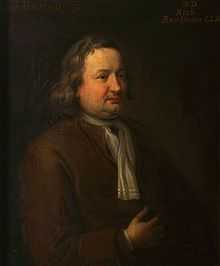John Bagford

John Bagford (1650/51, Fetter Lane, London – 5 May 1716, Islington) was a British antiquarian, writer, bibliographer, ballad-collector and bookseller.
Life
Originally a shoemaker by trade, he was active on the book-trading market from 1680 in and around Holborn, travelling to Haarlem, Leiden, and Amsterdam on this business and aiding such collectors as John Moore, Robert and Edward Harley, Sir Hans Sloane, Samuel Pepys and John Woodward. Becoming friends with fellow antiquarians such as Thomas Hearne, Humfrey Wanley and Thomas Baker, he published antiquarian tracts, contributed to others, and edited an edition of Geoffrey Chaucer published by John Urry.
Bagford, together with Humfrey Wanley and John Talman, was one of three ‘founder members of the reconstituted ‘Society of Antiquaries’, which first met at the Bear Tavern on the Strand on December 5, 1707.[1]
The Gray's Inn elephant tooth and stone tool
In 1715 Bagford wrote about the Gray's Inn Lane hand axe and the elephant tooth which had been found together by John Conyers opposite "Black Mary's". He asserted that the elephant was probably introduced by Claudius but that the tool had been made by human workmanship.[2] He described this as a "British weapon" and as such he was one of the first to suggest that stone age tools were human-made, rather than produced by other causes (such as lightning).
See also
- Bagford Ballads
References
- ↑ Sweet, Rosemary (2004). Antiquaries: The Discovery of the Past in Eighteenth-Century Britain. London: Cambridge University Press. p. 84. ISBN 1-85285-309-3.
- ↑ Archaeology – The Lower Palaeolithic Age | A History of the County of Middlesex: Volume 1 (pp. 11–21). British-history.ac.uk (2003-06-22). Retrieved on 2012-06-03.
External links
| Wikisource has the text of the 1885–1900 Dictionary of National Biography's article about John Bagford. |
- John Bagford in the Dictionary of National Biography (requires subscription)
- Portraits of Bagford at the National Portrait Gallery, London
- Article on Bagford (giving an erroneous birth year)
|